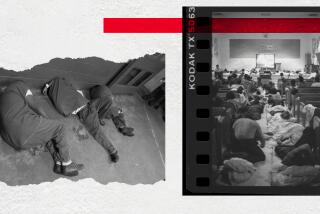Arkansas Prison Still Shackled to Dark Past
- Share via
VARNER, Ark. — Guards on horseback still watch inmates toil in fields, harvesting rice, cotton and corn from the rich, flat Delta land. Little seems to have changed at the Cummins Unit prison, which turns 100 years old in 2002.
These days, however, the guards are paid employees, not rifle-wielding trusties spending the rest of their lives in a 10,000-acre prison, once among the harshest in the nation. Punishment is meted out under strict guidelines, not through bullwhips and electric-shock devices.
Life has changed inside and outside the prison, where modern buildings have replaced old wooden cellblock structures.
“It looked like you were driving back in time to the 1800s,” said Kenneth Nicely, a convicted police killer who began serving a life term in 1958.
Inmates answered to few outsiders in the days before reforms.
“There were only eight or nine free-world people over four barracks with 160 people each,” recalled Nicely, 63, a slight, gray-haired man dressed in tattered white prison pajamas.
Dina Tyler, spokeswoman for the Arkansas Department of Correction, said prisoner oversight and awareness of human-rights abuses has improved drastically in the state system, which now houses 12,300 inmates.
Since 1970, she said, “there have been leaps forward.”
Back then, survival depended on inner strength and the ability to keep up with work demands on the prison farm, Nicely said. For those who couldn’t do the work, punishment was harsh.
“They would make you lie down on your stomach and whip you with a bull hide. I got whipped the first day I was on the hoe squad,” Nicely said.
“It was like being backed up against a heating stove all day long. At night, you couldn’t pull your shorts off. You had to take a shower and shake them loose,” he said.
Lucille Smith spent her first years of incarceration in a converted chicken coop--back when men and women were held at separate areas on the Cummins prison farm.
“When we first pulled up, we thought it was a joke. It looked like an old, run-down farmhouse with a fence around it that was waist-high,” said Smith, the longest-serving female inmate in the state prison system.
Smith, also a convicted police killer, began her life sentence in 1974. She now is held at the McPherson Unit for women that opened in Newport in 1998.
“Your worst day here isn’t as bad as your best day in Cummins,” said the 51-year-old.
The U.S. Supreme Court ruled in 1970 that the Arkansas prison system violated the Constitution’s prohibition of cruel and unusual punishment. The prison remained under federal supervision for the next 13 years.
A federal judge from the era declared the state prison system a “dark and evil world.” The prison system inspired Bobby Darin to write and record the hit song “Long Line Rider,” the nickname for the tough trusty work supervisors, and it became the model for the 1980 Robert Redford film “Brubaker.”
The state prison system was self-sufficient then, run in large part by the trusties, who were supported by the proceeds of their crops.
“It was the prevalent thing in all Southern prisons because it was cost-saving,” said Cummins warden Dale Reed. “Back in the ‘50s, the thought was that prisons could turn a profit.”
Reed hired on as a guard in 1973 at age 18; his father also worked at the penitentiary. A trusty trained Reed before Reed went to work supervising 600 inmates.
“The inmates [trusties] had most of the guns. They would be in the fields overseeing the long lines of 150 to 200 inmates,” he said. “Many of those inmates had a reputation for being able to shoot a goose out of the air with those rifles.”
Reed came at the end of an era, a time when inmates were slowly being disarmed and the state was regaining control of the system.
“In ‘69, they had taken the strap out of the picture and whippings didn’t happen when I got there,” he said. “The mentality was different back then. There was no due process, it would just happen on a whim.”
When Gov. Winthrop Rockefeller took office in 1967, he made prison reform a priority, declaring the Cummins Unit “probably the most barbaric prison system in the United States.”
A State Police investigation found brutality, extortion, murder, sadism and fraud.
As part of the reforms, Rockefeller commuted the death sentences of 14 death row inmates.
His son, Winthrop Paul Rockefeller, now lieutenant governor, said his father was motivated in part by the racial inequities within the system.
“Back then, you would get the death sentence many times just for the color of your skin,” he said.
When Rockefeller visited prisons, his bodyguard had to check his gun with a prison trusty.
“It didn’t matter if they were with the sheriff’s office, or a police department or an armed gubernatorial bodyguard. Armed people [from the outside] didn’t go into the barracks” for fear unarmed inmates might try to jump them and take their guns, said John Haley, who served on Rockefeller’s prison board and worked to reform the system.
“In 1967, there were only 35 employees at Tucker and Cummins combined,” Haley said. “There were nearly 300 armed guards, all of whom were inmates.”
Gov. Rockefeller brought in Thomas Murton to run the state prisons. Focusing on rumors of a secret prison burial ground, Murton unearthed a pauper’s cemetery in front of television cameras.
Inmate Samuel Billingsley, who entered Cummins in 1957, was among those who watched the cemetery excavation. He said rumors of unmarked graves had long circulated within the prison.
“All the older guys, everybody, said a lot of inmates were buried in there,” he said.
Murton’s successor, Robert Sarver, continued the reforms, and their legacy continues.
“In the introduction to criminal-justice textbooks, when they get to the corrections section, they always mention Tucker and Cummins and the ‘dark and evil world’ quote,” said Arkansas Board of Correction Chairperson Mary Parker. “Cummins particularly is the domino in prison reform that everyone remembers.”
In his nearly 30 years as a prison system employee, Reed said he has long fought the reputation of the Cummins Unit.
“In 2002, we will have 100 years here, but people cling to the bad things for a long time. It is hard to change the reputation of Cummins as a dark and evil place, but one day we will get that reputation buried somehow,” he said.
The prison, now accredited, suffered a setback last February, when a federal grand jury indicted six former guards on charges they shocked and tortured three Cummins inmates in 1998. Five pleaded guilty and the sixth was convicted.
Inmates are glad of most of the changes, but not all.
“Back then, you didn’t have to go to chow hall, they let you go fishing instead. In the wintertime you could always catch a rabbit in the cotton field,” Billingsley said.
And he said inmates often gambled, playing dice in their barracks.
“I like to see the place change, but I would also like to see it go back,” Billingsley said. “We had a lot of fun back then. I didn’t seem like you were locked up at times.”
More to Read
Sign up for Essential California
The most important California stories and recommendations in your inbox every morning.
You may occasionally receive promotional content from the Los Angeles Times.










